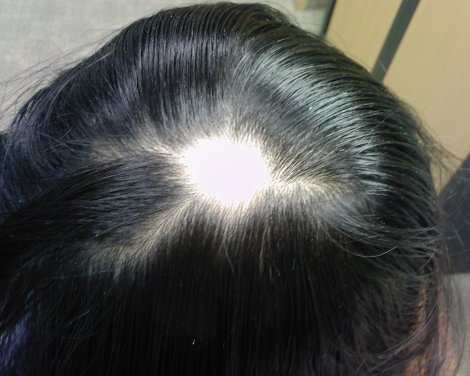Various Cases of Hair Loss in Children

Hair loss in children is more common than people think. Three children out of every hundred have alopecia problems; however, if it is diagnosed right, the hair loss can be successfully treated. If the problem occurs, the child should be taken to a pediatrician or pediatric dermatologist.
Here are various types of hair loss in children:
1. Tinea Capitis or ringworm of the scalp is the most common case of hair loss in children. This disease is caused by fungi which affect hair shafts in the skin of scalp, eyebrows and eyelashes. There are three types of tinea capitis, but black dot ringworm is most widely spread in the U.S. Children with the disease have very brittle hair that breaks off and falls out leaving patches of black dots. As a rule the patches are either round or oval. However, even if the patches are uneven, the possibility of ringworm is not excluded. Itching, crusting are scaling of the scalp are other symptoms of the disease.
The ringworm might go away without treatment, but in order to reduce the possibility of spreading some measures are strongly recommended. When a doctor finds out that a child has tinea capitis, he or she will prescribe some antifungal medicine that is taken by mouth. The most common one is griseofulvin. In order to decrease hair shedding and itching, it is recommended to use shampoos with selenium sulfide (2.5%) or zinc pyrithione (1-2%) two or three times weekly. Such shampoos are Head & Shoulders Intensive Treatment, Selsun, Selsun Blue and Nizoral are the best treatments.
2. Alopecia Areata is the most sudden type of hair loss. Sometimes it happens as quickly as within one night: a child wakes up with bald patches which are absolutely smooth without any signs of scaling, itching or inflammation. It is believed that the alopecia is caused by the immune system that attacks hair follicles. Another symptom of the disease is pitting or ridging nails.
Although it is shocking and unexpected the parents should not panic because with the proper treatment most patients’ hair grows back within a year or even sooner. However, 5% of children experience a further development of the disease: they lose all scalp hair (alopecia totalis) or even all body hair (alopecia universalis).
There has not been any special medicine developed to treat this disease because alopecia areata is so unpredictable that it is hard to make any studies on it. However, there are some drugs which might be prescribed because they are known to help certain percent of people with the disease. Some medications help to increase hair growth, but they cannot stop new patches from appearing. A child with alopecia areata should be under intensive care of a dermatologist.
3. Trauma of hair shaft happens with children a lot. One of the most common cases is when a baby rubs the back of his or her head on the bed and loses some hair which grows back as soon as the baby starts sitting up and spends less time in bed. There are two reasons for trauma: the above mentioned case is caused by friction; the other reason is traction which happens a lot with those who wear tight braids or pony-tails.
Trichotillomania is commonly misunderstood as another reason for trauma hair loss. Children that have habit to twirl or pluck their hair are usually hard to treat especially if the habit is old or occurs every time in the moments of despair.
Hair loss caused by trauma gets healed as soon as the trauma stops.
4. Telogen Effluvium is usually caused by stress, severe medical problems, certain prescription drugs or excess of vitamin A. When these things happen many hair strands “decide” to stop growing and fall out.
This hair loss condition is not a big thing to worry about: the hair will grow back and will be fully restored in about 3-6 months after the stress or other conditions are gone.
John Meyer
Posted on June 2, 2009
Filed Under Hair Loss, Hair Loss Conditions, Hair Loss Reasons, Hair Loss Treatments
Comments
Leave a Reply
